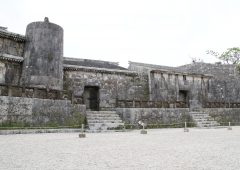2012.11.16
Osprey training held regularly; safety agreement said ignored
Since the first deployment of the MV-22 Osprey aircraft at the U.S. Marine Corps’ Futenma Air Station in Ginowan City more than a month ago, training involving the controversial aircraft has been held regularly but is said to have ignored a safety agreement between the two countries.
Ginowan City officials say since full deployment of the Osprey had the aircraft leaving the ground for training mostly weekdays. The United States deployed six Osprey tilt-rotor transport aircraft at the base on Oct. 1 and six more by Oct. 6. Officials say the aircraft flew regularly on routes between the station and training centers in northern and central Okinawa as well as on Ie Jima, a separate island west of the main island of Okinawa.
The aircraft has flown carrying concrete blocks and other materials at an auxiliary airfield on Ie Jima and training centers in central Okinawa. The first evening training took place on Oct. 23. Soon, training is expected that involves fully armed soldiers descending from the aircraft.
Since the full deployment, the Okinawa prefectural government has asked 27 local municipalities to gather information from residents about Osprey activities.
According to such witnesses, the aircraft had been seen operating like a helicopter, in vertical takeoff and landing mode, at low altitudes above residential areas across Okinawa main island. The joint agreement between Japan and the United States restricts such operations due to safety concerns about emergency landings in the mode. “The operations do not immediately violate the agreement,” Hirofumi Takeda, chief of the Defense Ministry’s Okinawa Defense Bureau, said.
Local residents are far from convinced, observers say. Meanwhile, the issue of Osprey deployment was taken up when the central government held a meeting with prefectural governors at the prime minister’s office. The Osprey is expected to be transferred to the Marine Corps’ Iwakuni base in Yamaguchi Prefecture, western Japan, and Camp Fuji in Shizuoka Prefecture, central Japan, for low-altitude flight operations on six routes above Honshu main island and Kyushu and Shikoku regions as well as on a route known as “Brown” over the Chugoku Mountains in western Japan.

 2024.07.07
2024.07.07 2024.06.21
2024.06.21 2024.05.15
2024.05.15 2024.02.07
2024.02.07 2024.01.31
2024.01.31 2023.11.02
2023.11.02 2023.10.26
2023.10.26 2023.09.29
2023.09.29 2023.09.01
2023.09.01






